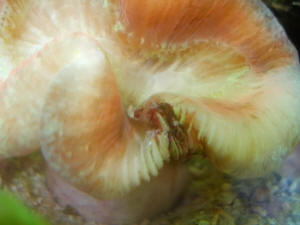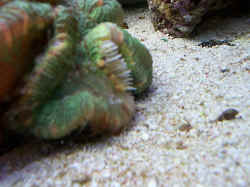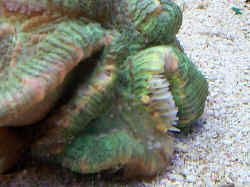|
FAQs about Trachyphylliid Coral Pathogenic Disease
FAQs on Open Brain Disease:
Trachyphylliid Disease 1,
Trachyphyllia Disease 2,
Trachyphyllia Disease 3,
Trachyphyllia Disease 4,
Trachyphyllia Disease 5,
FAQs on Open Brain Disease by Category:
Diagnosing, Environmental (Pollution/Poisoning, Lighting...),
Nutritional,
Social (Allelopathy),
Trauma,
Predatory/Pest,
Treatments
Related Articles: Coral Pests and Disease; pests, predators,
diseases and conditions by Sara Mavinkurve, Trachyphylliid Corals, Trachyphyllia Reproduction Report,
FAQs on Stony Coral Disease by Category: Diagnosing:
Environmental (Pollution/Poisoning, Lighting...),
Nutritional, Social (Allelopathy),
Trauma,
Pathogenic (Infectious, Parasitic, Viral)
Predatory/Pest,
Treatments
FAQs on Stony Coral Disease by Type: Brown Jelly Disease, RTN,
|
|
|
Trachyphyllia parasite 03/31/09
Greetings and Happy Spring!
<Thank you and sorry for the delay... did Michelle answer your
email? In case she forgot... I'll try to help.>
I received this small brain several weeks ago site unseen,
(online order) and it came to me with a slightly damaged area
that I found to be home to a nocturnal worm of some sort; the
area has continued to worsen. My plan is to try and remove the
creature with tweezers, and if that doesn't get it, to work
surgically, trying to remove flesh to expose the worm and then
clean the skeleton up with a Dremel. Does this seem like a
productive approach?
<Well, if you haven't done so already, no. It's highly
unlikely that this worm is the cause of the coral damage.
It's more likely that it is simply opportunistic. If you can
pull it out without troubling the coral much, then go ahead. But
don't cause more damage trying to do so. The best thing to do
is to just make sure your water quality is high, that the coral
has the right lighting and water flow, etc... and just hope it
recovers. Did you acclimate it properly?>
Would a freshwater bath be helpful or more damaging?
<more damaging>
Next, because as you may be able to see Cyano has found its way
to the exposed skeleton,
<typical>
does anyone ever use a petroleum jelly ointment of Neomycin
sulfate (eye ointment) in the marine system?
<Not that I've heard of... but it's an interesting
idea. I would take it out of the water before doing this though.
I'm not sure if it would do any good, but it's an
interesting though. If you care to experiment, I would remove the
coral from the water, apply the ointment, then cover it with an
inverted bowl (to keep moisture in)... or, cover it with a damp
paper towel. Then let it sit for a few hours. Then return it to
the tank. But again, I'm not recommending this... as I've
never heard of such a thing being done. But if you wanted to try
it, that's how I'd do it.>
Other than it being a petro/ mineral oil product, it's water
resistance might keep the antibiotics localized and in place
perhaps keeping the blue-green algae at bay.
<Yes, it is an interesting idea... >
The coral is inflating fairly well and eating even though looking
a wee bit bleachy due to misplacement in direct halide
lighting.
<This could also cause (or make worse) the damage you're
seeing.>
Any suggestions/cautions are very much appreciated, thank you.
Robert
<Please let us know how it works out.
Cheers,
Sara M.>
|
 |
Trachyphyllia-unidentifiable parasite 1/28/2009
Dear Wet Web Media,
<Hi Tina, Mich here.>
I have had a green open brain for 6 months. Upon arrival, I noticed a
small hole in the skeleton (about the size of a pencil head eraser).
The coral expanded and ate normally until the last three months. Around
the same time, I noticed the hole in the skeleton increasing in
size.
<I'm doubting this is causational.>
When a light is projected into the hole, I can see two dark brown tubes
that retract into the hole, followed by the plugging of the hole with a
round piece of coral skeleton.
<Hard to say without a picture but my best guess is a sedentary
snail.
They are generally harmless and can often be detected by the mucus net
they produce to capture food items.>
I have searched fruitlessly for information about what this creature
might be and if I should attempt to remove it.
<In my experience the hitchhikers I have found on such corals have
generally been harmless.>
Can you help me?
<I'm not finding a good image to show you, but perhaps the
written description is enough?
Thank you very much in advance for your time.
<Welcome! Do let me know if this fits the picture.>
Best Regards,
Tina Woodruff
<Cheers,
Mich>
Re: Trachyphyllia-unidentifiable parasite
02/08/09
Hi Mich,
<Hi Tina, Sara M. here.>
This explanation makes sense to me, but I have never seen the mucus net
that you mentioned.
<As Mich has said, without a picture it's hard to say. But I do
agree with Mich that this was likely a Vermetid snail.>
I have a company that maintains the larger of my two aquariums and they
removed the "creature" from the brain coral late yesterday
afternoon.
<Bad idea!>
It was very large in size (for living in a small open brain) and had
bored a large cave in the skeleton of the coral. It did not look like a
normal snail, but more like a small sea slug attached to a hard
operculum.
<Again, I suspect this was a Vermetid, like this one:
http://www.asira.org-a.googlepages.com/IMG_0469.JPG >
Do you still feel that this creature had a commensal relationship with
my brain coral and was likely a sedentary snail?
<Not so much "commensal"... the snail gets much more out
of the relationship than the coral. In fact, the snail might even be
considered mildly parasitic in that it does take food that might
otherwise come to the coral. But they don't really cause any real
harm.>
I guess my worry now is will the brain survive the surgery, but only
time and good care will tell. Do you have any suggestions?
<Again, I wouldn't have removed the thing... doing so likely
caused more stress than good. But now that it's done, I would just
leave the coral be.
Care for it as you normally would, with good water quality, target
feeding, etc.>
Thank you again for your time and the care you took in answering my
query, you guys really are the best.
<De nada.>
Best Regards,
Tina
<Cheers,
Sara M.>
Open Brain Sliming Good Morning! <It's evening! Trying
to trick me, eh...> I purchased a green/red open brain a couple of
weeks ago. It looked good, has expanded more in my tank than in the
LFS, but yesterday morning I noticed a bit of a translucent slime
around one edge. This morning it had extended to enshroud approx.
½ the coral. There is a bit of skeleton exposed on the edge
that first exhibited the problem. The edge where this started is up
against some live rock (wasn't touching when I placed the coral,
but it has since expanded and now touches a bit -- is that a
problem???) <I would not allow the extended tissues to touch the
rock, as it will become abraded in the extensions and contractions
these animals perform day to day> Is there anything I should
be doing other than wait and watch? Tank param.s: 52 g -- 20 in.
tall Lighting: 2- 96w PC actinics, 2- 175W 20000k MH Ca/Alk: 405/2.9
Temp: 78 -- 78.5 pH: 8.2 NO2/NO3 both 0 <If you have a coral of the genus
'Trachyphyllia' then the "sliming" behavior is
perfectly natural. These corals excrete a mucus coating to trap
floating particulates, and then ingest the entire coating. Make sure
you keep it well fed - M. Maddox>
Re: Open Brain Sliming - Brown Jelly Disease Well, it turned
out to be brown jelly. By this afternoon there was very little living
tissue left - probably 2/3 of the skeleton was fully exposed and what
little live tissue was left was breaking down and melting away.
<Ack! Remove that coral ASAP! It may be possible to frag and save
the healthy parts of the coral, but you do NOT want the 'brown
jelly' (a protozoan) spreading!> Are any of the following
organisms at risk from loose "jelly" being blown around in
the tank (GSPs, mushrooms, hammer coral, trumpet coral, pearl bubble
coral)? If so, is there anything I can do to lessen the risk? <All
LPS are at risk - remove the coral ASAP. If you don't have a QT
tank, just ditch the entire coral> I've started running charcoal
- don't know if that will help, but I guess it couldn't hurt...
<Never a bad thing, but it won't kill Protozoans. Make sure to
remove it ASAP, and keep a very close eye on your other LPS. In the
meantime, set up a quarantine tank if you don't already have
one!> Thanks, -Brian <Good luck - M. Maddox>
Re: Open Brain sliming & Brown Jelly Disease Follow-up I
took it out a few hours after my last post - there was no healthy
tissue left, but some of that stuff did get loose in the tank, some
when I was removing it and some due to my peppermint shrimp slicing and
dicing at it, so ... <Too bad :\ Quarantine next time!> I found
an article that suggested as a follow up to dealing with an infection
adding Vitamin C to the tank for 14 days according to some instructions
but the link to said instructions was dead - how do I do this? How much
and what form? Ground up C from the health food store?? An additional
recommendation was good flow to reduce the chances of the jelly being
able to collect, which I have. <Do not add ascorbic acid directly
(i.e. don't use human pills) as it will drop your pH drastically.
Instead, use a liquid\buffered supplement that can be found on any
online retailer's site> Thanks, Brian. <Anytime - M.
Maddox>
| Has He Lost His Brain? For the
last three days my open brain coral hasn't seemed to be opening
up very well. It seems like it has started to reseed on one lobe of
the coral. Tonight when I got home it had mostly white slime and a
little brown slime oozing off of it. The other 5 lobes seem to be
opening up a little bit. <Sounds like some form of infection. I
wonder if it was brought about by some injury. These corals are
often nibbled on by fishes, trampled on by crabs and shrimp, and
sometimes have difficulty removing sand that gets into them. All of
these things can lead to stress, and further decline> Is there a
way to help the coral heal itself? Should I do any dips? <Well,
you could try a 1 to 3 minute freshwater dip> Can feeding one
lobe of a open brain feed the coral as a whole? <I think that it
cannot hurt!> I think what happened is I didn't have it in
enough circulation due to a slight change in the rock structure.
Ever since I moved the rock around it wasn't happy. I have
attached some pictures so you can see the lobe. I hope you can help
me save this coral. <Well, moderate water flow is desirable for
these corals...Too much flow can damage the tissue and interfere
with their natural feeding processes. I'd try to increase the
feeding and see if this brings about a recovery. Also, make sure
that there are not tankmates "sampling" the coral...Once
injured, these corals are almost "irresistible" to
predators. Keep a close eye on your specimen. If you have further
concerns, let us know. I'm sure that Anthony might have some
more ideas if the coral does not seem to be improving. Good
luck!> Thanks, Ian Roff <And thanks for stopping by, Ian!
Regards, Scott F.> |
 |
 |
|
|

